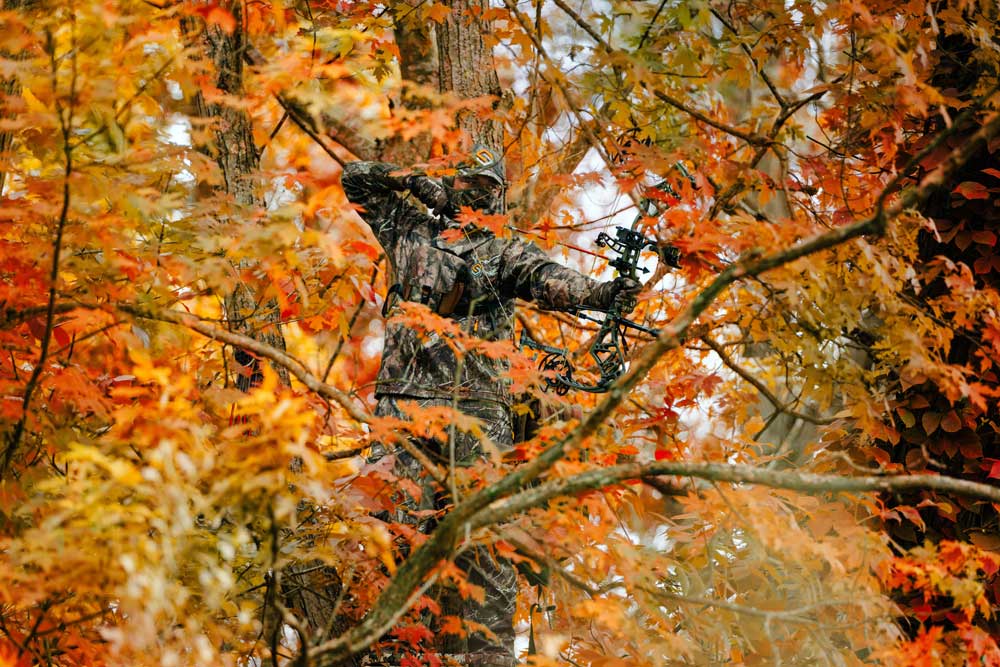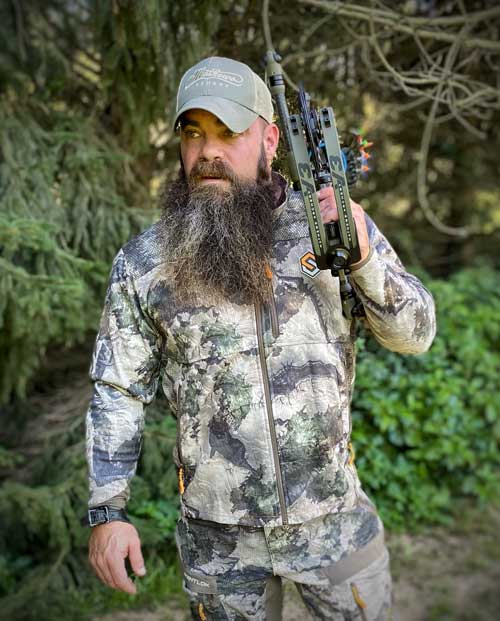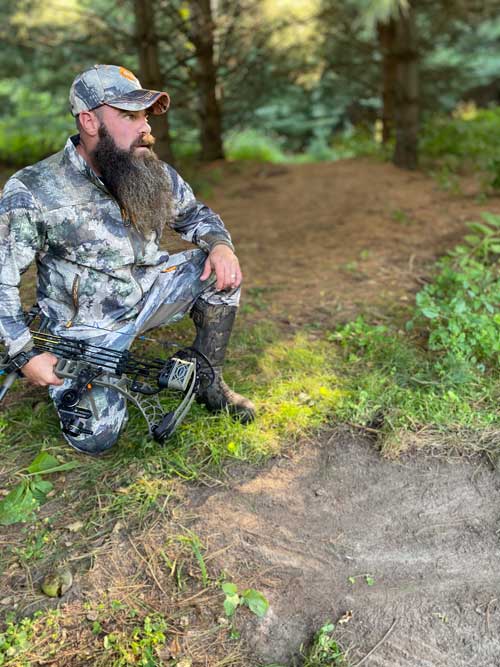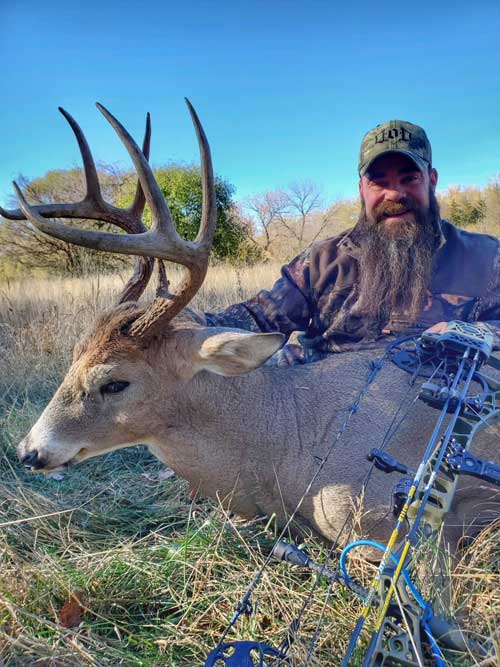Heath Wood

October is one of many changes; the leaves turn from the summer greens to the fantastic fall colors of oranges, reds, yellows, and browns. Changes occur in weather patterns; temperatures go from warm summer-like days to crisp frosty mornings. For a deer hunter, the month of October also consists of many changes in deer hunting. The feeding patterns of deer change; the bucks begin separating from their summer bachelor groups to start fighting with each other to see who the dominant buck for the upcoming November rut will be.
The popular term ‘October lull’ comes from deer changing behaviors and making deer movement seem less appealing. The many changes in deer behavior have led many hunters to get discouraged while hunting. However, the October behavior from bucks can be an exciting time if the hunter makes the proper adjustments. Drury Outdoors pro and Critical Mass cast member Sean Lundy says that mid to late October can be one of the most productive times to bow hunt.
The first week or two of October, bucks will sometimes still be together in their bachelor groups, as well as still in a late summer feeding pattern. This time is an excellent time for patterning bucks that are traveling from food sources to bedding areas. Yet, Lundy says hunters must be careful when hunting them.
“I will never hunt a larger food source early season in the mornings. Bucks are going to be in the food throughout the night and up into the morning hours,” Lundy said. “The risk is too high of busting a mature buck out of the food, so I choose to catch them coming into the food during the evenings instead.”
However, he goes on to say that if he finds a buck in a smaller wooded area or smaller food plot that is coming in during morning hours, he will consider hunting mornings. Overall, evenings only.

As the month goes on, Lundy says things begin to change. From October 20, he begins seeing opportunities to hunt mornings. From October 25 to around Halloween, Lundy says he begins seeing more mature bucks.
“In mid-October, you will start to see those 2 to 3-year-old bucks come out into fields looking for does,” Lundy said. “Those bigger bucks see that, yet the bigger bucks have been through a few ruts already, and they know the does aren’t ready yet.”
Lundy then finished by saying that the mature bucks can only take so much of watching the younger bucks chasing around the does before they can’t take it anymore and will show up to see what the action is all about.
“I have seen four or 5-year-old bucks during this time, not necessarily chasing, but they are ripping up scrapes, showing up on camera more, and showing up more during daylight hours,” said Lundy.
During the last couple of weeks of October, Lundy says he thinks hunters sometimes miss out on patterning a mature buck enough to make the harvest.
“I love November, and I will be hunting during November when mature bucks are chasing,” added Lundy.
The advantage to hunting in mid to late October is with scrapes. When bucks begin fighting for dominance, it doesn’t always mean taking their antlers and pushing each other back and forth until a winner is determined. Bucks also compete by making and using scrapes.
“Bucks will compete with each other by scraping up the woods and competing by trying to stake their territory and attract nearby does,” said Lundy. “When bucks start using scrapes and our regularly checking them, that is when they can be more patternable compared to November. In early November when bucks began the chasing process, scrapes get somewhat, pushed to the side.”
He says that bucks will still check scrapes during November; however, it is much less than October. To take advantage of scraping activities, Lundy likes to add to the competition by making mock scrapes or urinating in a bucks scrape itself.

When making a mock scrape, it is vital to remember scent control. Hunters must wear rubber boots such as the Lacrosse AeroHead Sport rubber boots. The AeroHead Sport boots help reduce odors around the scrapes and are easy to clean quickly. It is also essential to wear scent control clothing such as ScentLok powered by carbon alloy technology that helps control human odors and always spray down with a scent eliminating spray like Scent-A-Way from Hunters Specialties. Lundy says he likes to get off the food sources and get back into the timber.
“I like to find travel corridors that are in the timber that go from bedding areas to food sources,” said Lundy.
Travel corridors found in the heavy timber cover are a great place to find scrapes and create mock scrapes. Another great place to find scrapes is along the edge of small food plots, which is where Lundy likes to make mock scrapes in the open to attract deer out into the shooting range. Lundy says he takes post-hole diggers and places a small sapling or branch in the middle of a small food plot to make his mock scrapes.
“I use a natural doe urine in my mock scrapes with a game camera in front of them throughout October,” said Lundy.
He adds that does will check or use the mock scrapes throughout the entire month of October, then around the third week of October, the mature bucks will show up.
“During that third week, you will see nighttime pictures start to pick up of mature bucks checking the scrapes, and then they will start checking more and more as the days go on,” said Lundy.
He then added that bucks would stop by and check scrapes periodically without using the scrape. During this time, Lundy will use an estrus scent or a Buck Bomb around the scrape area to try and get a buck interested, or he will urinate himself into the scrape.
“I know it sounds crazy, but I first heard of it from an outfitter a few years back. They would have a contest who could get the biggest buck on camera, and that was one of the things they did to get bucks fired up,” said Lundy. As for doing this unique tactic himself, Lundy says he will urinate in the scrape, and within a day, a buck will re-open the scrape. “I never urinated in a mock scrape where a buck came by and only smelled and went on. Every time the next picture will be the buck re-opening the scrape,” added Lundy. He then went on to say it is almost like it aggravates them enough to want to put their scent back in instead; it is a dominance tactic that keeps them interested.

Lundy says that late October, specifically the 27th, 28th, up to Halloween, are the best days to hunt in October.
“When scrapes are hot, it is time to be in the stand,” said Lundy. He added that scrapes usually dry up during the second week of November when bucks start chasing, and the actual rut is in full swing. Lundy says he has had many days of success during those last few days of October by hunting and using mock scrapes. Another reason Lundy says he loves hunting during the last week of October is to take advantage of the 2, and 3-year-old bucks who are beginning to chase does first.
“I killed one of my biggest bucks after I watched a couple of younger bucks chase around a doe until she was almost worn out. Then all of a sudden I can hear grunting almost like that of a cow coming through the woods, and there was no doubt it was a mature buck coming,” explained Lundy. “It is almost like the mature bucks sit back and wait for the young bucks to run down the doe until the last minute, and then they swoop in and go in to breed her.”
Is October deer hunting the best month of the year? It is hard to compete against the rutting action that occurs during November. However, the change in weather and the change in deer behavior that occurs in October is something that hunters should not ignore. Do not chalk up October as a lull or slower time to hunt while holding out for November; instead, go for it in October. Young bucks trying to beat the presence of the more mature bucks, and the competition of scrapes along with man-made mock scrapes can make for some of the most exciting days of hunting that one will encounter. And it could also very well be that extra chance of scoring on a mature buck that every hunter wants.




























